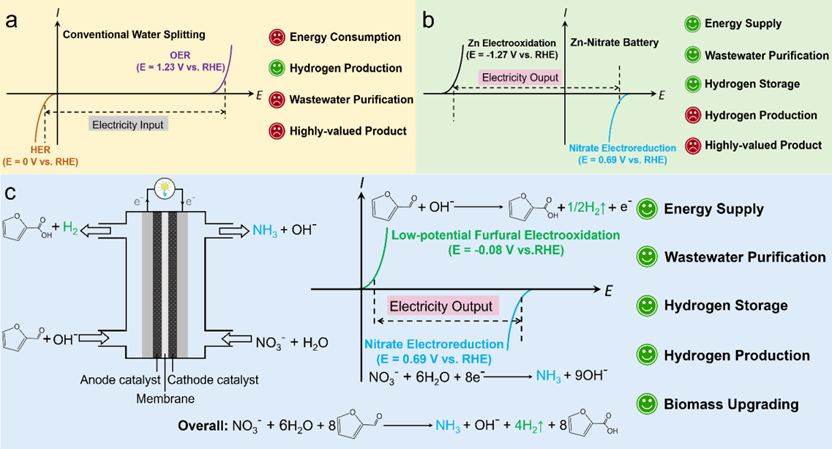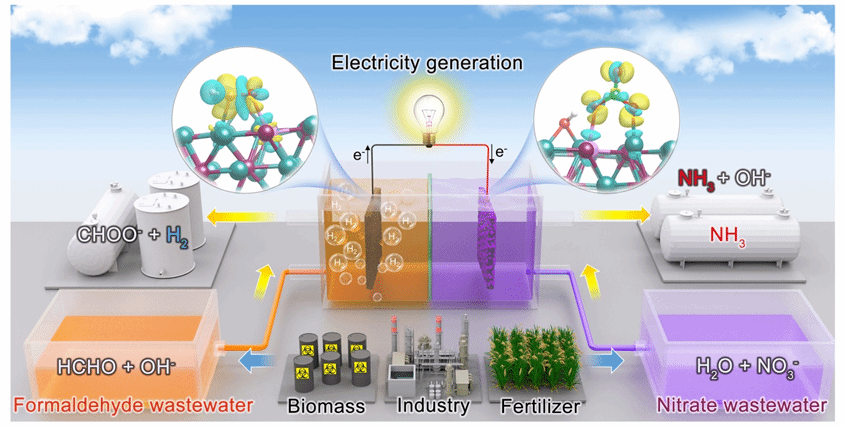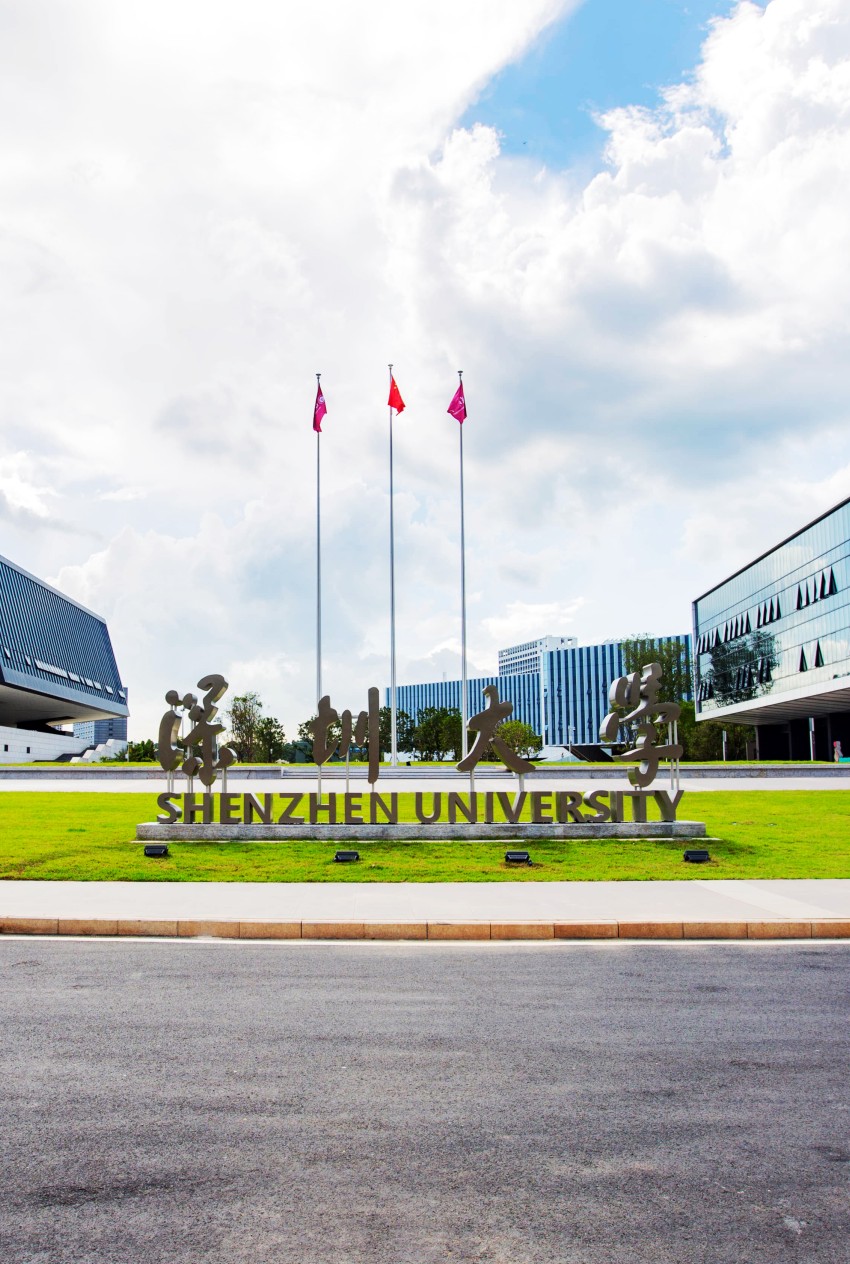Since the global fossil energy resources are gradually depleting and environmental issues become increasingly severe, the advanced technologies for obtaining green energy carriers (hydrogen, ammonia) with clean conversion and utilization of waste streams have garnered significant attentions in the world. The global industrialization and agriculturalization processes produce large amounts of nitrate and aldehydes (e.g. furfural, formaldehyde) wastes and pollutants, posing major hazards to human health and ecosystems. Due to the grand challenges associated with current purification technologies, such as high energy consumption, long processing times, and significant costs, their application still faces considerable hurdles.
Recently, the research team led by Assistant Prof. ZHAO Bin and Chair Prof. LUO Jing-Li at the College of Materials Science and Engineering in Shenzhen University devoted a series of research efforts focusing on the design and application of novel "aldehyde-nitrate" catalytic energy storage battery system. Related research findings have been successively published in Angewandte Chemie International Edition and Advanced Materials, in which ZHAO Bin and LUO Jing-Li serve as the co-corresponding authors.

Achievement 1: By rationally coupling the clean conversion of industrial and agricultural wastes (nitrate and biomass-derived furfural), a multifunctional electrochemical catalytic energy storage system is designed. This system utilizes RhCu alloy nanowires/copper foam (RhCu NW/CF) as a bifunctional electrocatalyst, significantly optimizing the kinetics of the nitrate reduction reaction (NO3RR) and the furfural oxidation reaction (FFOR). By modulating hydrogen transfer behaviors, RhCu NW/CF enables the efficient conversion of nitrate and furfural into various non-mixed, high-value products (such as NH3, H2, etc.) while simultaneously generating electrical energy. This system not only achieves wastewater purification, cathodic ammonia (NH3) production, anodic hydrogen (H2) production, and biomass chemical upgrading (yielding furfurate), but also demonstrates good discharge performance and economic value, offering new insights for sustainable energy solutions.
Article Info: Xin Long, Bin Zhao*, Danni Liu, Guodong Fu, Hang Yang, Renfei Feng, Ning Chen, Hekun Ding, Jiayi Wu, Yuanfeng Liao, Shaoqing Liu, Yu Zhang, Xian-Zhu Fu, Jing-Li Luo*. Manipulation of Hydrogen Transfer Behaviors by RhCu Alloying Enables an All-in-one Sustainable “Furfural-Nitrate” System. Angewandte Chemie International Edition, 2025, 64, e202503424.

Achievement 2: The team successfully designed and synthesized a bifunctional electrocatalyst composed of Pd single-atom doped Cu3P quantum dots (Pd-Cu3P SA-QDs). By moderately optimizing the H* adsorption behavior, this catalyst dual-directionally accelerates the kinetics of both the nitrate reduction reaction (NO3RR) and the formaldehyde oxidation reaction (FOR), thereby simultaneously achieving high activity and selectivity for cathodic ammonia (NH3) synthesis and anodic hydrogen (H2) production. Specifically, the onset potential for NO3RR is as high as +0.36 V (vs. RHE), with a Faraday efficiency (FE) for NH3 reaching 99% at –0.3 V (vs. RHE). Meanwhile, the onset potential for FOR is as low as –0.07 V (vs. RHE), with FEs for formate and H2 exceeding 90% and 95% respectively at 0.3 V (vs. RHE). Notably, by integrating NO3RR with anodic FOR, a galvanic cell system was established, exhibiting an open-circuit potential of 0.892 V, a peak power density of 12.1 mW cm–2, and capable of generating 8.8 kWh kg–1 of electrical energy. Importantly, the constructed "formaldehyde-nitrate" galvanic cell system not only enables electrical power output but also synchronously purifies wastewater in a non-mixed manner, producing high-value-added H2, NH3, and formate chemicals, providing a green environment and clean energy for a sustainable future.
Article Info: Rida Javed, Bin Zhao*, Zulakha Zafar, Qianqian Zhao, Arunpandiyan Surulinathan, Ning Chen, Renfei Feng, Yu Zhang, Xian-Zhu Fu, Jing-Li Luo*. Pd Single-Atoms Doped Cu3P Quantum Dots with Moderately Optimized H* Sorption Behaviors for Actualizing the Multifunctional “Formaldehyde-Nitrate” Galvanic System. Advanced Materials, 2025, 37, e12332.
Article Links:
Achievement 1: https://doi.org/10.1002/anie.202503424
Achievement 2: https://doi.org/10.1002/adma.202512332
Shenzhen University is the primary affiliation for the above works, and Assistant Prof. ZHAO Bin is the first corresponding author for both publications. The research was supported by the National Natural Science Foundation of China (General Program), the Guangdong Basic and Applied Basic Research Foundation, the Shenzhen Science and Technology Program, and other funding sources.
Editor: Zhang Xiaoying
Layout:
Reviewers: Wang Dong, Wang Lei
